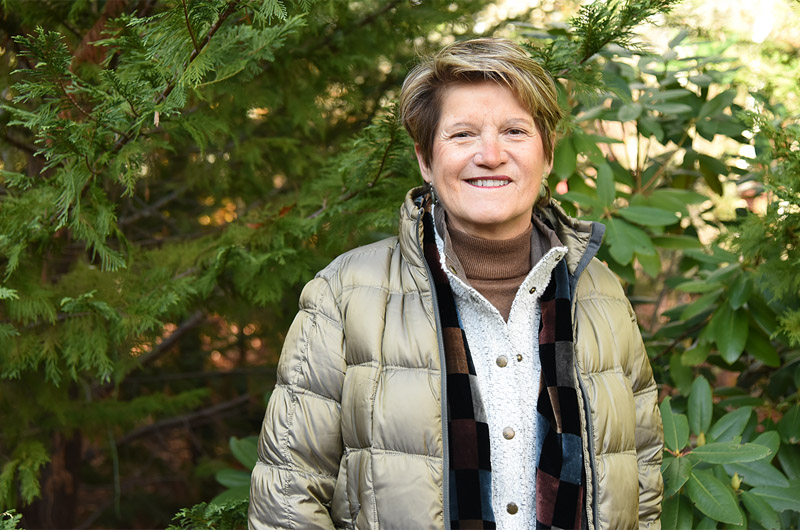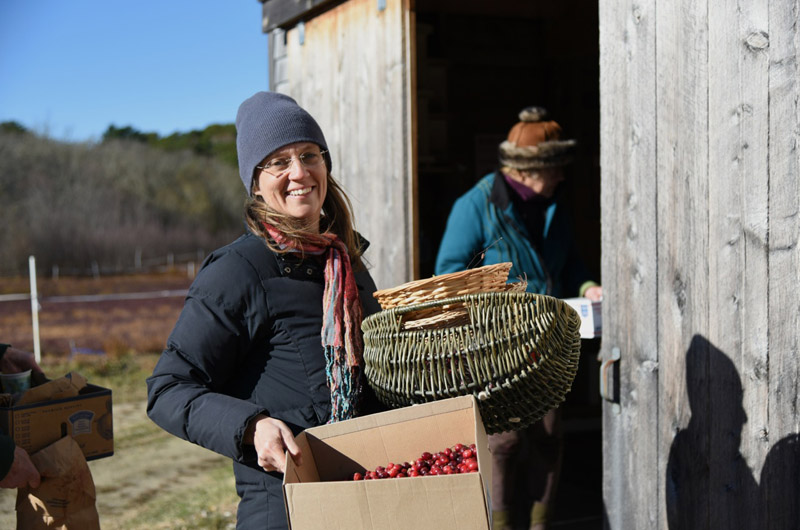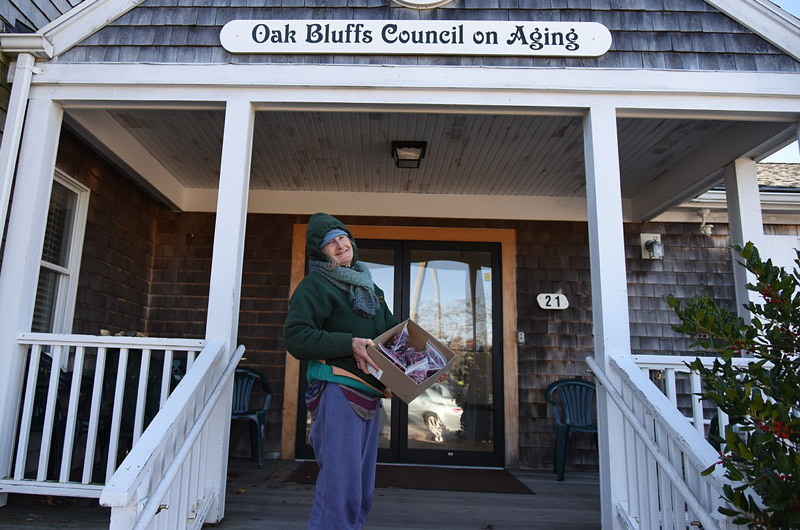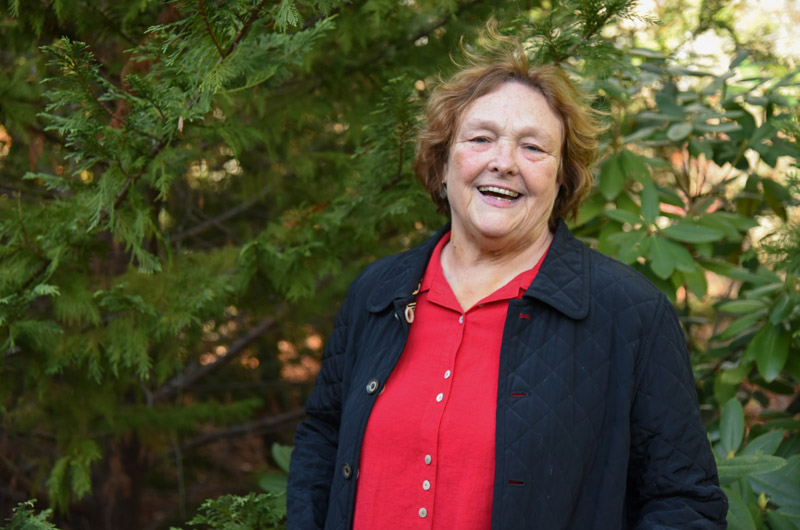The Martha’s Vineyard Boys & Girls Club no longer charges for after-school snacks, because so many children don’t have money to pay for them.
The Island Food Pantry serves nearly 500 families a year. Senior citizens Islandwide rely on Meals on Wheels, food distributions and low-cost lunches at elder centers. One of every four students in the Vineyard’s public school system qualifies for a free or reduced-price lunch. Parents are skipping meals to feed their kids.
Hunger is a part of daily life for many Vineyarders, although it is not always visible.
“My anxiety is through the roof,” said Esther Laiacona, a single working mother of two young children who lives in Edgartown and relies on the federal Supplemental Nutritional Assistance Program (SNAP, formerly known as the Food Stamp Program) to help make ends meet each month. “It’s meant to be supplemental, so you still need a cash budget to meet your food needs,” she said.
And on an Island where housing, food and fuel all cost more than on the mainland, there’s a lot of competition for that cash. “I can’t afford to make my son’s lunch every day, and that is really frustrating for me because he’s a very picky eater,” Ms. Laiacona said. “I just can’t afford it — never mind after-school snacks. They love cheese sticks, but we can only buy cheese sticks twice a month.”
About 115 Island kids a day receive free after-school snacks at the Boys & Girls Club in Edgartown, and that number is growing, said executive director Jessie Damroth, an Island native who recently returned to take the helm at the club. One of her first orders of business when she took over in September was to abolish the paid snack counter and vending machines that had served only children with money in their pockets.
“I don’t want to set hungry kids apart,” Ms. Damroth said in a recent interview. “I don’t want them to stick out. All kids need food. “A mother herself, Ms. Damroth sees many children after school whose only meal was pre-noon school lunch. “You see it in their eyes,” she said. Without the club snack, these youngsters might get nothing more to eat until suppertime. Ms. Damroth finds that unacceptable: “Kids can’t be hungry here,” she said. “We have so much.”
Now the Boys & Girls Club snack service under Ms. Damroth has evolved into a program called Healthy Happy Kids, soon to launch officially with a menu of rice bars, yogurt bars, pasta bars, oatmeal bars and bento box bars. A nutrition expert will train club staff over the next few weeks, Ms. Damroth said.
Varying statistics from a patchwork of sources make it difficult to sketch a comprehensive picture of hunger on Martha’s Vineyard. “We still have to get our hands exactly on the numbers,” said Island Grown Initiative executive director Rebecca Haag, who is spearheading a movement to make good food available to Islanders of all incomes. But recent figures from social service agencies indicate that the Vineyard is a much hungrier place than many Islanders and most visitors might believe.
More than 300 Island households, totaling 576 people, received SNAP benefits during the month of March, 2016, according to information provided by the state Department of Transitional Assistance in Greenfield. The amount of food assistance provided to Islanders through the program during that month totaled $34,235, via electronically-funded bank cards that heads of households use to buy food at local markets. Intended to supplement income, the cards are replenished with fresh funds on the first day of each month.
“That last week of the month, God help us all,” Ms. Laiacona said. “You’re skipping meals so your kids can have meals. For me that’s a very tense time of the month, those 10 days before the SNAP benefit comes in.”

In her work as a services counselor for Dukes County, Vineyard Health Care Access and Community Action for the Cape and Islands, Ms. Laiacona helps Island residents with referrals for social services. She said she meets many other Islanders who are striving to cope with food insecurity, as well as steep utility bills and housing costs.
“Starting Oct. 1, I did about 31 food stamp applications and 24 fuel assistance applications,” she said. “I also provided emergency food assistance to about 15 households.” Families with urgent needs received help from her office, Health Care Access and the Committee on Hunger. She stores food in her own kitchen and car, for when emergencies occur after hours.
“I saw an average of four people a day in October alone, so about 80 people in one month,” said Ms. Laiacona, whose office hours are four days a week at the county administration building near the airport. “Every single person had a food need of some kind,” she said. Many clients already received SNAP benefits but had encountered some kind of glitch, such as losing the SNAP card or needing to renew it, or simply had a food gap that needed to be met. “The food pantry opened, so many were referred to the pantry,” she said.
Many of her clients are women, particularly single mothers. Most are of working age.
“I see a lot of people born in the 1950s,” she said. “They’re not old enough to retire, but something has changed in their job situation — age related, or an injury or illness.” Other clients are homeless, or may have just been released from jail. “They haven’t eaten in days; they’re starving,” Ms. Laiacona said. Young people aged 19 to 23 make up the smallest proportion of people seeking aid, she said.
Along with small children, single parents and people who are ill, elderly Islanders are among the most vulnerable to food insecurity, with hundreds a day relying on free and low-cost meal services. Jacque Cage, a longtime leader in social work on the Island who works with Elder Services of Cape Cod and the Islands, said her senior nutrition program served 46,739 meals to Vineyard seniors in the 12 months from July 1, 2015 to July 1, 2016. The nutrition program operates Meals on Wheels and senior dining centers.
Hunger is a part of daily life for so many Vineyarders that at Ms. Haag’s prompting, more than a dozen community agencies, nonprofits and volunteer groups have formed a network in response. In late October, Island Grown Initiative, the Boys & Girls Club, Vineyard Committee on Hunger and Martha’s Vineyard Community Services joined other Island organizations for a first-of-its-kind Island food equity summit. Vineyard business owners, including Meg Athearn from Morning Glory Farm and Steve Bernier of Cronig’s Markets, were also among the 30 participants, as were several representatives from Wampanoag Tribe social services.
“So many of us are involved in this work, and yet gaps and barriers still exist,” Ms. Haag wrote in her invitation to the meeting. “None of us wants to duplicate efforts of others or waste energy solving a problem, only to find out that someone else has taken the lead. After speaking to many of you, there seems to be a desire to better understand each of our organizations’ roles, to coordinate our efforts and to share our resources as needed.”
The all-day event yielded three working groups that will be reporting back after 90 days in late January, Ms. Haag said. Each team is studying a specific problem that emerged during summit discussions: data collection and communication in order to understand the scope of the Vineyard’s hunger problem; reaching children with fresh food; and improving the infrastructure (trucking, sorting, processing and storage facilities) needed to support Island organizations providing food to those in need.
A more informal gathering, over savory Indian food last Sunday at the Chilmark Community Center, celebrated the work of the Island Grown Initiative’s gleaning volunteers. Gleaners work in partnership with Island farms and market gardeners to harvest surplus produce — greens, potatoes, squash, fruit and more — which is then donated to feed families around the Vineyard. Morning Glory Farm, the gleaners’ first farm partner in 2009, recently reached a milestone of 100,000 pounds of fresh produce donated through the gleaning program. “We’ve harvested 21,352 pounds for the season and we’re still counting,” gleaning program director Jamie O’Gorman told the luncheon group.
One of the final gleans of the season was held early this week at the Vineyard Open Land Foundation cranberry bogs off Lambert’s Cove Road in Vineyard Haven. Like all the produce gleaned this year, the cranberries will be donated to community groups including senior centers.
When freshly-gleaned fruits and vegetables come into the Anchors in Edgartown, seniors “grab them up,” council on aging chef Diane Wall told the luncheon group.

Yet apart from a banner celebrating the gleaners’ achievements, and the purple Food Pantry donation boxes at Island supermarkets, there are few external signs that hundreds of Islanders are struggling to feed themselves and their families. More than 11 per cent of the Vineyard’s year-round population lives in poverty, according to the U.S. Census Bureau’s Small Area Income and Poverty Estimates.
Meanwhile, Thanksgiving was a little easier this year for about 250 Island households after Family-to-Family, a program of the all-volunteer Vineyard Committee on Hunger, distributed packages of turkeys, produce and other groceries purchased with donated funds. The next Family-to-Family distribution takes place Dec. 16. The hunger committee is seeking donations to help purchase food for Christmas meal packages. “This is the time of year we have to get our contributions,” said Betty Burton, who leads the Committee on Hunger.
On the Vineyard, “hunger has many faces,” Ms. Haag said.
This is the first in a series about hunger and food insecurity on the Vineyard.










Comments (39)
Comments
Comment policy »